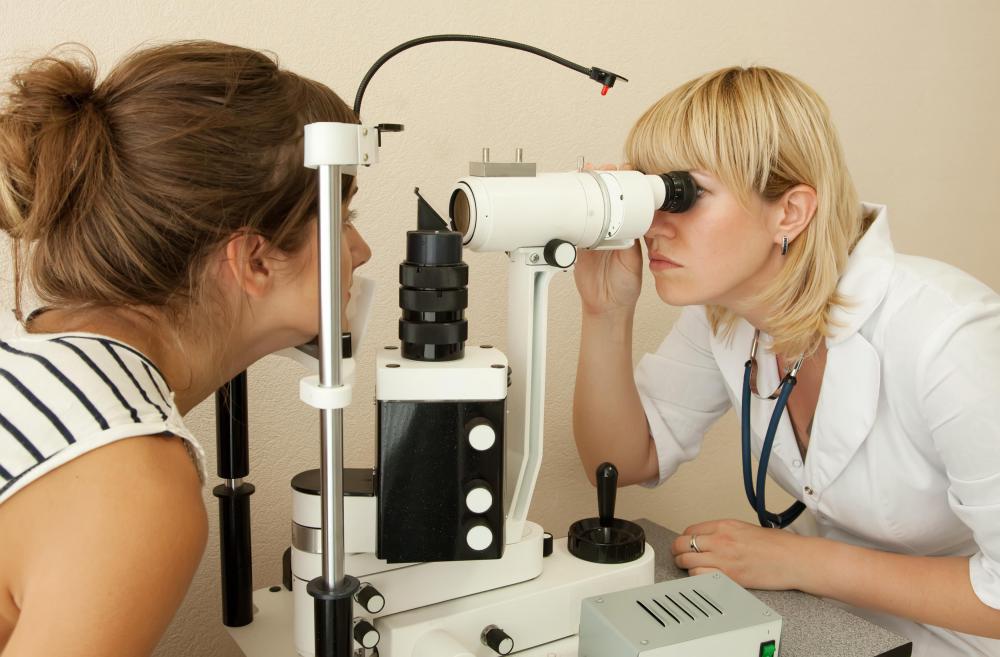At TheHealthBoard, we're committed to delivering accurate, trustworthy information. Our expert-authored content is rigorously fact-checked and sourced from credible authorities. Discover how we uphold the highest standards in providing you with reliable knowledge.
What is the Optic Nerve?
The optic nerve is a bundle of tissue that transmits the signals generated from the eye to the brain. In essence, the optical nerve is the connection between the eye and the brain. It consists of a grouping of over one million nerve fibers, although the tissue of the optic nerve is actually more closely related to brain tissue than to nerve tissue.
When light enters the eye, it first passes through the cornea. The cornea functions much as a lens cover on a camera does. The cornea bends the entering light to direct it towards the pupil and iris. The iris is the colored part of the eye and the pupil is the black circle in the middle of the eye.

The pupil regulates the amount of light that enters the eye. The pupil dilates, or enlarges, when there is less surrounding light, allowing more light to enter the eye. Conversely, the pupil decreases in size when there is a lot of surrounding light, limiting the amount of light that is allowed to enter.
The entering light then passes through the lens of the eye. The lens helps focus the entering light onto the back of the eye. This area of the eye is known as the retina, which is a light-sensitive layer of nerve cells that converts the light is received to electrical impulses which are sent to the brain via the optic nerve. Interestingly, the light and corresponding image is actually focused upside down onto the retina.

The electrical impulses that are transmitted to the brain via the optic nerve are then perceived by the brain as an image. Even though the image is initially focused upside down on the retina and transmitted in the same fashion, the brain perceives the image as being right side up.
Because the optical nerve is the conduit between the eyes and the brain, any problems associated with it can cause problems with vision. Optic nerve hypoplasia is a condition that occurs when the optical nerve does not develop fully during pregnancy. This can cause mild to severe vision impairment in one or both eyes.

It is not known exactly what causes optic nerve hypoplasia and it is not believed to be a hereditary condition. While there are some studies that indicate that there may be a connection between mothers with diabetes, maternal drug and alcohol abuse, maternal age less than 20 years, and the use of anti-epileptic drugs by a mother during pregnancy; research shows that these factors are not factors in a majority of the cases of optic nerve hypoplasia.
In addition to optic nerve hypoplasia, conditions such as disease, injury, diabetes, hypertension, drug, alcohol or tobacco abuse can affect the ability of the optical nerve to function properly, possibly causing vision impairment or even blindness.
AS FEATURED ON:
AS FEATURED ON:

















Discussion Comments
@Qohe1et
I would disagree that eyes are the primary sense. People who are blind are able to experience feeling and understanding on a deeper level that we all know. It is like a sixth sense, the profound spiritual and unconscious sense of love, affection, pain, and emotion. This deeper sense is literally an inexplicable soul-bound sense that stays with us even after death.
The eye is truly the window to the soul. Our brain is literally sitting right behind our eyes, and this is probably one of the big reasons that we look people in the eyes when we talk to them. It is the most intimate and detailed form of understanding the outside world.
The optic nerve is the closest that the brain gets to being exposed. The brain is pretty much right behind our eyeballs, and light is transmitted through the lens directly to the brain via the optic nerve. There is no other system in which the brain comes so close to the physical outside world.
Post your comments